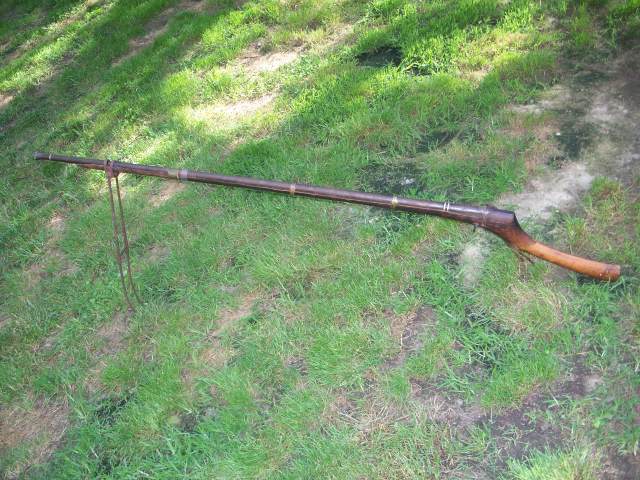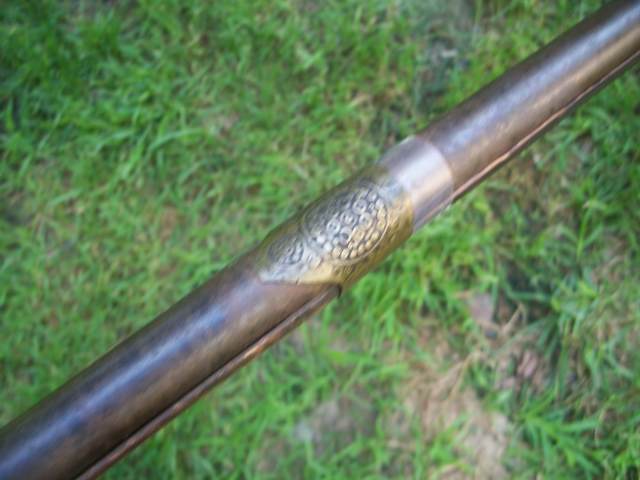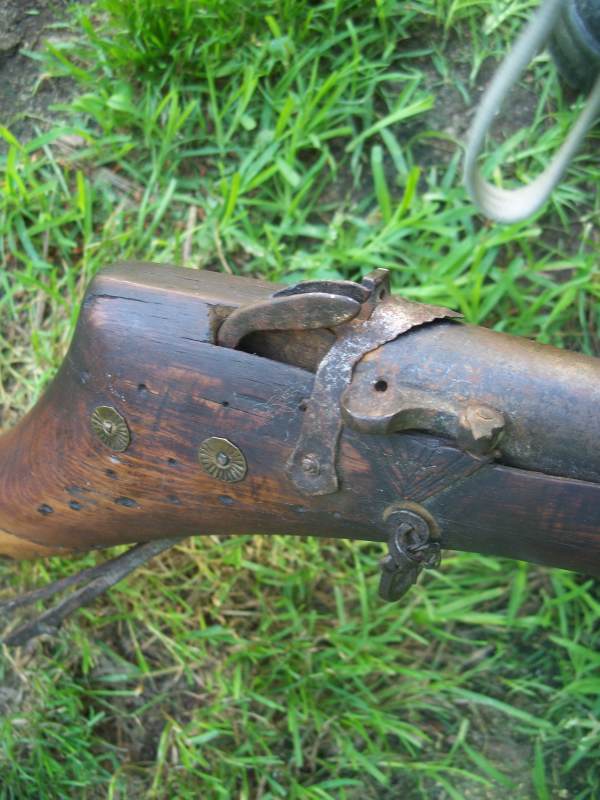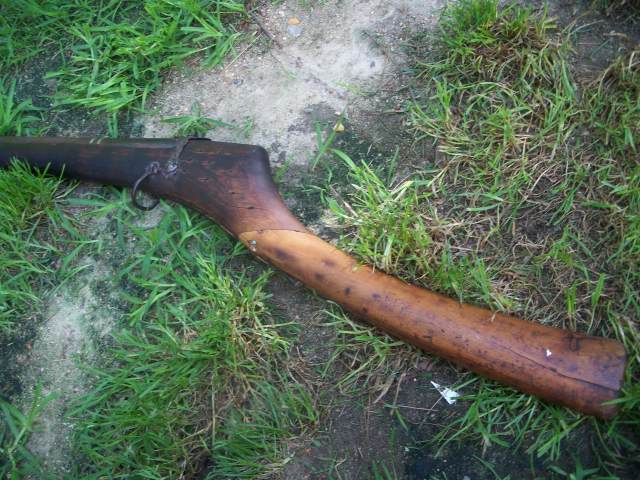
 |
|
|
#1 |
|
Member
Join Date: Oct 2009
Location: Gyeongsan, South Korea
Posts: 57
|
I just won the bid on a jezail matchlock, although I won't see it for a while yet, as I won't be back to the States until next weekend. The thing that interested me most about it was the barrel length (58"), as I'm researching certain Korean matchlocks, which had similar length barrels and are classified as wall guns; the biggest difference is, the seller said the bore was .50 cal. or a bit larger, while Korean wall guns had bores around .92 cal.
Just wondering if anyone had any guesses as to this one's age, origin, and any other info (pictures are the seller's, but I put them on my site so that it would use my bandwidth and not someone else's--I'll take my own pics of it after I get back to the States):    
Last edited by bluelake; 17th June 2010 at 12:04 PM. |
|
|

|
|
|
#2 |
|
Member
Join Date: Oct 2009
Location: Gyeongsan, South Korea
Posts: 57
|
Any ideas on it?
|
|
|

|
|
|
#3 |
|
Member
Join Date: Mar 2009
Posts: 28
|
If I might, whatthehell, that barrel band and bipod sure looks like it's adapted from a Japanese Type 99. Definite, impressive migration of parts and recycling or improvisation if that's the case.
|
|
|

|
|
|
#4 |
|
Member
Join Date: Dec 2004
Location: California
Posts: 1,036
|
Congratulations on a very interesting piece. It belongs to a large family of continental Asian muskets of very similar dimensions and configurations, formerly in wide use in Eastern Iran, Afghanistan, the central Asian khanates and emirates, and on into Tibet and China. Characteristic features are not only the forked barrel rest but the slender butts that are held against the shoulder, and the Turco-Persian matchlock with a non-snapping, forward-falling serpentine. There are minor regional differences in buttstock profile; the more deeply-recurved ones like this were prevalent in the western regions mentioned above; Tibetan stocks tend to be all but straight (somewhat resembling the Indian torador), and the Chinese ones tend to fall in between.
The conical expansion of the exterior of the muzzle is a common feature on many of these guns, and on toradars as well. Yours could well be from Central Asia; I once saw a photo taken late in the 19th cent. of an armory in a palace in Bukhara or Khiva, with several dozen guns just like this one hanging on a wall. (drool! pant!) Contrast this with the typical muskets of SE Asia, Japan, and Korea, which are of Indo-Portuguese origin -- short butts braced against the cheek, and locks having a snapping serpentine powered by a leaf or V spring on the exterior, released by a horizontal sear protruding through the lockplate and activated by a free-hanging trigger. Please refer to the appendices of Howard L. Blackmore's GUNS AND RIFLE OF THE WORLD (NY: 1965) for diagrams of characteristic musket butts and matchlocks which illustrated these differences, along with photos of the guns themselves. LASTLY, A WORD ABOUT THE BARREL REST -- this is not from a Japanese Arisaka rifle. The Type 99 infantry rifle of World War II had a MONOpod, not a BIpod -- it was formed of a continuous heavy steel wire which essentially took a specially shaped "U" bend at the bottom where it rested on the ground while in use. The bend was designed in such a way that the unit would also hug the contour of the stock when folded, with minimal protrusions. What you see here is a two-legged barrel rest, which is typical on many guns from the regions named previously, and which was also seen on early Mughal toradars prior to the mid-17th cent. These traditional bipods were so popular in parts of Siberia and the Tibetan plateau that they were often installed by tribesmen on modern rifles well into the 20th cent. I've seen pics of Buryat and Kham nomad hunters with these legs adapted to fit Mosin-Nagant and Mauser bolt-action rifles. |
|
|

|
|
|
#5 |
|
Member
Join Date: Oct 2009
Location: Gyeongsan, South Korea
Posts: 57
|
Thanks, Philip!
|
|
|

|
|
|
#6 |
|
Member
Join Date: Oct 2009
Location: Gyeongsan, South Korea
Posts: 57
|
Would you think this one is 19th C.--or maybe earlier?
|
|
|

|
|
|
#7 |
|
Member
Join Date: Dec 2004
Location: California
Posts: 1,036
|
Hi, Thomas
These things are notoriously hard to date for two reasons: (1) The design remained static for centuries. Matchlocks with forked rests depicted in hunting vignettes in early Mughal Shah-namehs don't vary significantly from those in battle-scenes rendered by Jesuit artists accompanying the Qianlong Emperor's victorious campaigns in Central Asia in the 1750s, or those captured on film by British and Russian photographers in Afghanistan, Persia, and the khanates at the end of the 1800s. (2) Not only was the technology long-lived, the guns themselves lasted a long time in active service. Old barrels of good quality were treasured heirlooms not only in the areas under consideration, but also amongst the Bedouins, Moroccans, and other peoples, who often preferred them to new ones. Guns were often restocked or otherwise refurbished, and sometimes modernized with the substitution of flint or percussion locks. I notice that your musket's buttstock is of a different color than the breech and forward areas, indicating an old repair. Considering that some Afghan tribesmen still used jezails until a couple of generations ago, and that in some remote Indian villages, farmers were using toreadars to repel or poach marauding tigers until the 1970s, it's easy to imagine that your gun's components could possibly embrace a working life that spans a century or two. |
|
|

|
|
|
#8 |
|
Member
Join Date: Oct 2009
Location: Gyeongsan, South Korea
Posts: 57
|
Thanks, Philip! Much appreciated.

|
|
|

|
 |
|
|